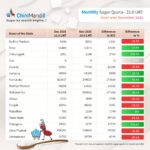The mountain just gave birth to a mouse
Aesop was a story-telling slave who lived in Ancient Greece around 600 years before the Christian era. His fables, which would always carry a popular morality or a lesson of intelligence, sagacity and justice, were (and still are) part of the childhood of generations and generations. How not to remember the fables of “The Ant and the Grasshopper”, “The Fox and the Grapes”, “The Tortoise and the Hare”, among others? The title of this comment is by him. The mountain that gave birth to a mouse originated in Aesop’s fables and describes actions that promise a lot, but deliver little: something as big as a mountain produced something as little as a mouse. I’m talking about the expectation that the maturity of the options this Friday was bringing for this week. It turned out to be a non-event.
All attention now is focused on the expiration of the March contract, which occurs Tuesday, February 28. End consumers are now the major pillar of the market (out of the four mentioned in our comment two weeks ago, the other three being the funds, the mills that are too fixed, and the short uncovered calls which expire today). And, repeating what we have said, what are we to expect from a market when a meaningful volume of sugar starts showing up in the Center-South?
New York closed out Friday at 21.41 cents per pound for March/2023, a 17-point drop against the previous week, while May/2023 closed out at 19.83 cents per pound, falling off 21 points over the week. The other months closed out almost unchanged.
The Brazilian currency strengthened slightly against the dollar over the week, closing out at R$5.1657 affecting the values in real per ton of the export sugar which fell off R$26 per ton for the 2023/2024 crop. All the President of the Republic has to do is keep his mouth shut and the market will adjust itself.
How about the position of the funds? No one knows. CFTC informed that next February 24 (Friday) they will release the report that should have been released on February 3 (3 weeks late!!!) is unbelievable. Then they will make all the efforts to finally normalize everything by mid-March. That can make any underdeveloped country envious.
On a different note: has the sugar market changed levels? The increase in the production cost of the commodity affected by the price increase of various inputs such as chemical pesticides, diesel, among others and mainly motivated by the war which caused a temporary shortage of some elements in the chain of fertilizers and other factors, have contributed to an increase of between 35-45% in the total cost, if compared to that before the pandemic. Sixteen cents per pound – a level we understand to be the absolute floor of the market – is the new 13 cents per pound (which was the support of the market in the past).
You can ask whether this argument holds itself up. Let’s see, then: we took the daily closes of the first futures contract traded in NY since 2000, converted into real per ton based on the exchange rate of the day, supplied by the Central Bank of Brazil and, then, adjusted all the values to today’s prices using the IPCA methodology. Based on this data, we see that only 25% of the times has the market been below the equivalent to 12 cents per pound, that is, selling puts at this exercise price seems like pulling a lollipop out of a child’s mouth. Half of the times it has been above 14.25 cents per pound. And for those who like Fibonacci, 38% of the times it has been above 16 cents per pound.
Nice Carnival everybody. In Brazil, as we know it, the year starts after Carnival. It’s high time.
To read the previous episodes of World Sugar Market – Weekly Comment, click here
To get in touch with Mr. Arnaldo, write on arnaldo@archerconsulting.com.br















